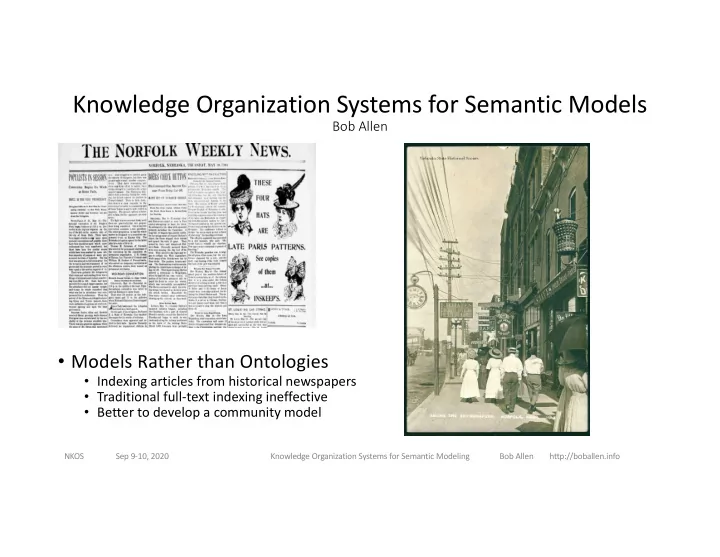

Knowledge Organization Systems for Semantic Models Bob Allen • Models Rather than Ontologies • Indexing articles from historical newspapers • Traditional full-text indexing ineffective • Better to develop a community model NKOS Sep 9-10, 2020 Knowledge Organization Systems for Semantic Modeling Bob Allen http://boballen.info
Direct Representation of Scientific Research Reports • Models rather than Ontologies • Models are integral to research reports • Snowball Earth theory • Geological claim that the earth may have frozen over completely – an extreme ice age • Main question – how the earth escaped that extreme ice age • In this talk, we will consider some issues for how to build these models • Specifically, the relationship of knowledge representation systems to object-oriented programming languages • These models have complex objects and systems (parts, states, mechanisms), microworlds, and context NKOS Sep 9-10, 2020 Knowledge Organization Systems for Semantic Modeling Bob Allen http://boballen.info
From Upper Ontologies to Object-Oriented Models • Upper Ontology (Basic Formal Ontology - BFO) • Establishes categories of entities allowed in application ontologies • Realist, Aristotelian, Universals/Particulars • Main distinctions: • Continuants/Occurrents • Independent Continuants/Dependent Continuants • Programming Languages • Basic Features: • Data Types, State Machines, Guard Conditions, Threads, Concurrency, Conditionals • Object-oriented Analysis, Models, and Programs • Smalltalk is a better example of object-oriented programming than Java. • Language Features: Inheritance, Classes and Methods • Typical Applications: Microworlds Knowledge Organization Systems for Semantic Modeling Bob Allen http://boballen.info NKOS Sep 9-10, 2020
Representation of Semantics of Complex Objects (#1) • Transitionals (implement state changes) • BFO focuses on Processes, but state changes seem equally important • Conditions on whether a transition will occur • Sequences of Transitionals are common • Mechanisms, Workflows, Other sequences • Natural language verbs have semantic roles, which should be applied in semantic modeling. • Relationships • BFO Core relationships (“inheres in”). • Increasingly, BFO applications include ad hoc relationships. • Many ad hoc relationships are actually events • If there is a person, there is necessarily a birth event • Rules/Axioms • Rules are like ad hoc relationships about the world we are trying to model. • Example: “Predators eat Prey” • Definitions • Describe what implied about the relationship of the given object to other objects • A waterfall must have water and a stream with a drop. • A bakery must have a baker, an oven, and baked goods, and be a commercial establishment. • For modeling, we need a structure to describe these connections. Knowledge Organization Systems for Semantic Modeling Bob Allen http://boballen.info NKOS Sep 9-10, 2020
Representation of Semantics of Complex Objects (#2) Parts: Different senses of Part_of (Winston, et al., 1987) • Component/Integral object (handle/cup, punchline/joke) • Parts associated with activities • Distinct functional units or structural parts. • Feature/Activity (paying/shopping) • Subprocess/Process. • Segments of an activity may be modeled with states and threads. • Portion/Mass (slice/pie, grain/salt) • If a portion is distinct, it may be a fiat-object part • Place/Area (Everglades/Florida, oasis/desert) • Nested spatial regions or nested sites • Member/Collection: (tree/forest, card/deck) • Object aggregates, such as “a heap of stones” and “a symphony orchestra” • Stuff/Object: (gin/martini, steel/bike) • A material and an object made from it. Knowledge Organization Systems for Semantic Modeling Bob Allen http://boballen.info NKOS Sep 9-10, 2020
Representation of Semantics of Complex Objects (#3) • States and Stages • Simple states attach dependent continuants • Complex states are more difficult. Is ice a different entity that liquid water? • Representation issues • Perhaps it is the state of an aggregate of water molecules, but the details are not clear. Allen, R.B. Issues for Using Semantic Modeling to Represent Mechanisms, arXiv: 1812.11431 • Configurations of Components and Scenarios • A person and the shirt they are wearing • Meta-operators, Yoked material entities Knowledge Organization Systems for Semantic Modeling Bob Allen http://boballen.info NKOS Sep 9-10, 2020
Representation of Semantics of Complex Objects (#4) • Functions • In BFO, Functions are Realizable Dispositions • For example: “the function of amylase is to break down starch into sugar” • Depends on context Microworld programmed with • Systems semantic modeling framework. • A foundation of programming languages • Composed of interacting mechanisms • Many complex objects can be considered as systems • Microworld • Environment for interacting objects • Can include gravity, temperature, pressure, etc • Focus on specific issues by nesting microworlds • Could be conceptualized as a type of system Allen, R.B. and Jones, T.K., XFO: Toward Programming Rich Semantic Models (April2018), arXiv:1805.11050 Knowledge Organization Systems for Semantic Modeling Bob Allen http://boballen.info NKOS Sep 9-10, 2020
Example: Semantic Model of Cardio-Pulmonary System Constructed purely from local interaction (message passing) between material entities. Allen, R.B., Definitions and Semantic Simulations Based on Object-Oriented Analysis and Modeling, 2019, ARXIV 1912.13186 NKOS Sep 9-10, 2020 Knowledge Organization Systems for Semantic Modeling Bob Allen http://boballen.info
Evidence and Discourse • Evidence • Snowball Earth model is based on a lot of details geological evidence. • Evidence has its own model that needs to be related to the broader model. • Collecting evidence • Workflows for the collection of evidence • Measurement procedures • Style of presentation in a research report • One approach: Tracking the emergence and synergies of the model and the evidence • A second approach: Direct Model descriptions • Follow the mechanisms of the model. • Ideally, one framework could support both approaches. NKOS Sep 9-10, 2020 Knowledge Organization Systems for Semantic Modeling
Conclusion • We describe a modeling framework that is centered on complex objects. • We have discussed solutions to several modeling puzzles. • Future work can include more advanced Object-oriented modeling techniques such as: • Actors model (can include timing of interactions) • Object-oriented system dynamics • Overall, modeling is a useful perspective. NKOS Sep 9-10, 2020 Knowledge Organization Systems for Semantic Modeling Bob Allen http://boballen.info
Recommend
More recommend